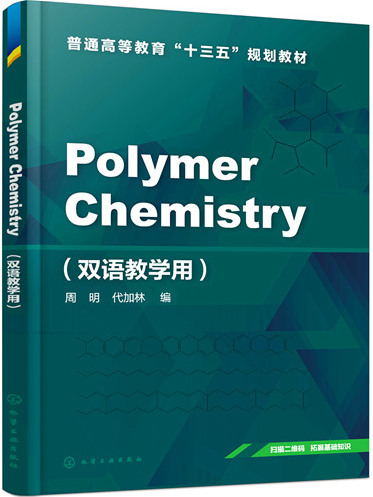內容簡介
The textbook is divided into eight chapters.In the introduction,the basic concept of polymer,classification and nomenclature of polymer,reaction type of polymer,development history of polymer and application of polymer are introduced in brief.In the next six chapters,free radical polymerization,free radical copolymerization,ionic polymerization,step polymerization,ring-opening polymerization and chemical reactions of polymers are introduced in detail.The implementation methods of polymerization are introduced systematically in the last chapter.The new words and terminology are noted in Chinese in detail,and the large exercises are attached at the end of each chapter,which is helpful for the students who are new to polymer chemistry to study smoothly.
This book is used as the textbook for colleges and universities.It is suitable for the major of Polymer Materials and Engineering,Material Chemistry,Material Science and Engineering,New Energy Materials and Devices,New Energy Materials and Engineering,Chemical Engineering and Technology,Applied Chemistry in engineering,Chemistry,Organic Chemistry,Analytical Chemistry,Polymer Chemistry and Polymer Physics in science,and Chemistry in normal colleges.It can also be used as the reference for junior college,scientific researchers and production technicians.
《Polymer Chemistry(雙語教學用)》共分8章。首先在緒論中介紹了聚合物的基本概念、聚合物的分類和命名、聚合物的反應類型、聚合物的發展歷程、聚合物的套用等。接下來6章分別就
自由基聚合、自由基共聚、離子聚合、逐步聚合、開環聚合、聚合物的化學反應進行詳細介紹。最後1章較系統地介紹聚合實施方法。書中對專業生詞和專業術語做了較詳細的中文註解,另每章後都附有習題,有利於初接觸到高分子化學的學生順利學習。
目錄
Chapter 1 INTRODUCTION1
1.1BASIC CONCEPTS AND DEFINITIONS1
1.1.1Monomers and Polymers1
1.1.2Structural Unit and Repeating Unit2
1.1.3Dimers,Trimers and Oligomers3
1.1.4Linear Polymers3
1.1.5Branched Polymers4
1.1.6Crosslinked Polymers4
1.1.7Stars and Dendrimers4
1.1.8Ladder Polymers5
1.1.9Copolymers5
1.2AVERAGE MOLECULAR WEIGHT AND DISTRIBUTION7
1.3TYPES OF POLYMERS AND POLYMERIZATIONS9
1.3.1Condensation Reactions9
1.3.2Addition Reactions10
1.3.3Ring-opening Polymerizations10
1.4POLYMERIZATION MECHANISM11
1.4.1Step Polymerization11
1.4.2Chain Polymerization11
1.4.3Comparison of Step and Chain Polymerization12
1.5NOMENCLATURE OF POLYMERS13
1.5.1Nomenclature Based on Source13
1.5.2Nomenclature Based on Structure(Non-IUPAC)14
1.5.3Trade Name14
1.5.4IUPAC Structure-Based Nomenclature System15
1.6A BRIEF HISTORY OF SYNTHETIC POLYMERS16
1.6.11838-1930’s16
1.6.21930-1945’s17
1.6.31945-1960’s17
1.6.41960-1980’s18
1.6.51980-2000’s18
1.6.62000-2018’s19
1.6.7Prospect of Polymer Materials19
1.7HISTORY OF NOBEL PRIZES FOR POLYMER SCIENCE20
1.8APPLICATION OF POLYMERS20
Exercises1 21
Chapter 2 FREE-RADICAL POLYMERIZATION23
2.1INTRODUCE23
2.1.1Initiators24
2.1.2Monomers25
2.1.3Solvents and Systems26
2.2INITIATION27
2.2.1Initiation by Thermal Decomposition of Initiators27
2.2.2Initiation by Redox Reactions29
2.2.3Initiation by Photolytic and Ionizing Radiation29
2.2.4Reactions of Initiator Radicals with Monomers29
2.3RADICAL CHAIN PROPAGATION30
2.4CHAIN TRANSFER REACTIONS31
2.5FREE RADICAL CHAIN TERMINATION32
2.6KINECTICS OF FREE RADICAL POLYMERIZATION33
2.6.1Approximations34
2.6.2Steady-state Concentrations of the Propagating Radicals35
2.6.3Theoretic Rate of Polymerization36
2.7AVERAGE KINETIC CHAIN LENGTH39
2.8AVERAGE DEGREE OF POLYMERIZATION AND AVERAGE MOLECULAR WEIGHT40
2.9EFFECT OF CHAIN TRANSFER ON AVERAGE DEGREE OF POLYMERIZATION41
2.10DEPENDENCE OF THE DEGREE OF POLYMERIZATION ON TEMPERATURE43
2.11DISTRIBUTION OF MOLECULAR WEIGHT44
2.11.1Disproportionation Termination44
2.11.2Combination Termination45
2.12INHIBITOR AND RETARDER46
Exercises2 47
Chapter 3 FREE-RADICAL COPOLYMERIZATION51
3.1TYPES AND NAMENCLATURE OF COPOLYMERS51
3.2REACTIVITY RATIO AND COPOLYMER COMPOSITION EQUATION52
3.3COPOLYMERIZATION BEHAVIOR54
3.3.1Ideal Copolymerization54
3.3.2Alternating Copolymerization56
3.3.3Non-ideal Copolymerization56
3.3.4""Block"" Copolymerization57
3.4EXPERIMENTAL DETERMINATION OF ACTIVITY RATIOS57
3.5VARIATION OF COPOLYMER COMPOSITION WITH CONVERSION58
3.6EFFECT OF MONOMER STRUCTURE ON REACTIVITY60
3.6.1Conjugation Effect60
3.6.2Polarity Effect60
3.6.3Steric Effect61
3.7Q-e EQUATIONS61
3.8DISTRIBUTION OF MONOMERS IN A COPOLYMER63
Exercises3 65
Chapter 4 IONIC POLYMERIZATION67
4.1ANIONIC POLYMERIZATION68
4.1.1Initiators for Anionic Polymerization68
4.1.2Monomers for Anionic Polymerization70
4.1.3Solvents70
4.1.4The Mechanism of Anionic Polymerization(General)71
4.1.5Living Polymers and Copolymerization72
4.2COORDINATION POLYMERIZATION73
4.2.1Ziegler-Natta Catalyst73
4.2.2Composition of the Catalyst74
4.2.3Polymerization Mechanism75
4.3CATIONIC POLYMERIZATION76
4.3.1Initiators for Cationic Polymerization76
4.3.2Monomers for Cationic Polymerization78
4.3.3The Mechanism of Cationic Polymerization78
4.3.4Special Characteristics of Classical Cationic Polymerizations80
4.4KINETICS OF IONIC POLYMERIZATION80
4.4.1Anionic Polymerization81
4.4.2Cationic Polymerization87
Exercises4 91
Chapter 5 STEP POLYMERIZATION93
5.1INTRODUCTION93
5.1.1Types of Condensation Reactions94
5.1.2Requirements for High Molecular Weight95
5.2SPECIFIC CONDENSATION POLYMERIZATIONS95
5.2.1Linear Polyesters95
5.2.2Branched and Crosslinked Polyesters96
5.2.3Polycarbonates97
5.2.4Polyamides(nylons)98
5.3KINETICS OF STEP POLYMERIZATION99
5.3.1Equal Reactivity of Functional Groups99
5.3.2Rate of Polymerization Reactions99
5.3.3Kinetics of Polyesterification100
5.4TIME DEPENDENCE OF THE AVERAGE DEGREE OF POLYMERIZATION103
5.5MOLECULAR WEIGHT DISTRIBUTIONS105
5.6EFFECT OF NONSTOICHIOMETRIC REACTANT RATIOS108
5.7BRANCHED AND CROSSLINKED CONDENSATION POLYMERS111
5.8THE METHOD OF STEP POLYMERIZATION114
5.8.1Melt Condensation Polymerization115
5.8.2Solution Polymerization116
5.8.3Interfacial Polycondensation116
5.8.4Solid Phase Polycondensation117
5.9RANDOM PREPOLYMERS AND STRUCTURE PREPOLYMERS118
5.9.1Random Performed Polymers118
5.9.2Structure Prepolymers119
Exercises5 122
Chapter 6 RING-OPENING POLYMERIZATION126
6.1INTRODUCTION126
6.2CHARACTERISTICS OF RING-OPENING POLYMERIZATION 126
6.3POLYMERIZATION ABILITY OF CYCLIC MONOMERS127
6.4THERMODYNAMICS OF RING-OPENING POLYMERIZATION OF CYCLOALKANES127
6.5THERMODYNAMIC AND KINETIC CHARACTERISTICS OF CYCLOALKANE POLYMERIZATION128
6.6IMPORTANT RING-OPENING POLYMERIZATION IN INDUSTRY130
6.6.1Cyclic Ether130
6.6.2Cationic Ring-opening Polymerization of Carbonyl Compounds and Acetals133
6.6.3Ring-opening Polymerization of Cyclic Amides134
6.6.4Cyclosiloxane137
Exercises6 138
Chapter 7 REACTIONS OF SYNTHETIC POLYMERS139
7.1REACTIONS INVOLVING THE MAIN CHAIN139
7.1.1Addition Reactions139
7.1.2Reactions that Generate Skeletal Unsaturation140
7.1.3Hydrolytic Chain Cleavage140
7.1.4Enzymatic Degradation of Synthetic Polymers141
7.1.5Oxidation Reactions142
7.1.6High Temperature Degradation Reactions143
7.1.7Electron Beam Depolymerization147
7.2REACTIONS INVOLVING THE SIDE GROUPS147
7.2.1Principles of Polymer Reactivity147
7.2.2Hydrolysis of Side Group Structures148
7.2.3Chloromethylation of Polystyrene150
7.3GRAFT POLYMER FORMATION151
7.4CROSS-LINKING REACTION152
7.5SURFACE REACTIONS OF POLYMERS153
7.5.1Surface Fluorination153
7.5.2Surface Nitrification and Sulfonation154
7.5.3Surface Oxidation154
Exercises7 155
Chapter 8 METHODS OF POLYMERIZATION156
8.1BULK (MASS) POLYMERIZATION156
8.2SOLUTION POLYMERIZATION157
8.3SUSPENSION POLYMERIZATION157
8.4EMULSION POLYMERIZATION159
8.4.1Description of Process160
8.4.2Quantitative Aspects168
8.4.3Other Characteristics of Emulsion Polymerization176
8.4.4Soap-Free Emulsion Polymerization179
8.4.5Inverse Emulsion Polymerization180
8.4.6Miniemulsion Polymerization181
8.4.7Microemulsion Polymerization181
8.4.8Seed Emulsion Polymerization181
8.4.9Core-shell Emulsion Polymerization182
8.4.10Dispersion Polymerization182
8.4.11Living Radical Polymerization182
Exercises8 184
REFERENCE185

